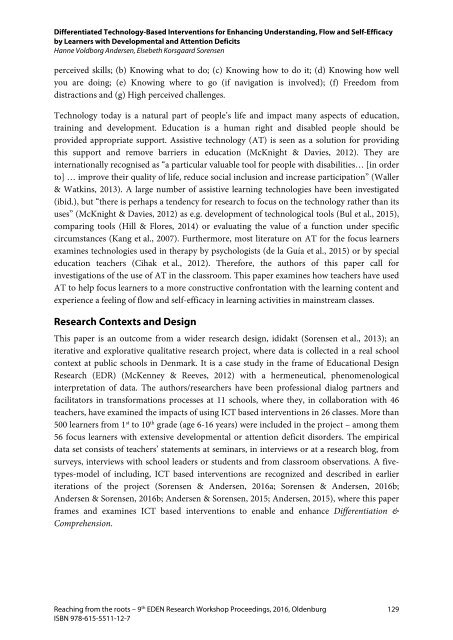Forging new pathways of research and innovation in open and distance learning
RW_2016_Oldenburg_Proceedings
RW_2016_Oldenburg_Proceedings
Create successful ePaper yourself
Turn your PDF publications into a flip-book with our unique Google optimized e-Paper software.
Differentiated Technology-Based Interventions for Enhanc<strong>in</strong>g Underst<strong>and</strong><strong>in</strong>g, Flow <strong>and</strong> Self-Efficacy<br />
by Learners with Developmental <strong>and</strong> Attention Deficits<br />
Hanne Voldborg Andersen, Elsebeth Korsgaard Sorensen<br />
perceived skills; (b) Know<strong>in</strong>g what to do; (c) Know<strong>in</strong>g how to do it; (d) Know<strong>in</strong>g how well<br />
you are do<strong>in</strong>g; (e) Know<strong>in</strong>g where to go (if navigation is <strong>in</strong>volved); (f) Freedom from<br />
distractions <strong>and</strong> (g) High perceived challenges.<br />
Technology today is a natural part <strong>of</strong> people’s life <strong>and</strong> impact many aspects <strong>of</strong> education,<br />
tra<strong>in</strong><strong>in</strong>g <strong>and</strong> development. Education is a human right <strong>and</strong> disabled people should be<br />
provided appropriate support. Assistive technology (AT) is seen as a solution for provid<strong>in</strong>g<br />
this support <strong>and</strong> remove barriers <strong>in</strong> education (McKnight & Davies, 2012). They are<br />
<strong>in</strong>ternationally recognised as “a particular valuable tool for people with disabilities… [<strong>in</strong> order<br />
to] … improve their quality <strong>of</strong> life, reduce social <strong>in</strong>clusion <strong>and</strong> <strong>in</strong>crease participation” (Waller<br />
& Watk<strong>in</strong>s, 2013). A large number <strong>of</strong> assistive learn<strong>in</strong>g technologies have been <strong>in</strong>vestigated<br />
(ibid.), but “there is perhaps a tendency for <strong>research</strong> to focus on the technology rather than its<br />
uses” (McKnight & Davies, 2012) as e.g. development <strong>of</strong> technological tools (Bul et al., 2015),<br />
compar<strong>in</strong>g tools (Hill & Flores, 2014) or evaluat<strong>in</strong>g the value <strong>of</strong> a function under specific<br />
circumstances (Kang et al., 2007). Furthermore, most literature on AT for the focus learners<br />
exam<strong>in</strong>es technologies used <strong>in</strong> therapy by psychologists (de la Guía et al., 2015) or by special<br />
education teachers (Cihak et al., 2012). Therefore, the authors <strong>of</strong> this paper call for<br />
<strong>in</strong>vestigations <strong>of</strong> the use <strong>of</strong> AT <strong>in</strong> the classroom. This paper exam<strong>in</strong>es how teachers have used<br />
AT to help focus learners to a more constructive confrontation with the learn<strong>in</strong>g content <strong>and</strong><br />
experience a feel<strong>in</strong>g <strong>of</strong> flow <strong>and</strong> self-efficacy <strong>in</strong> learn<strong>in</strong>g activities <strong>in</strong> ma<strong>in</strong>stream classes.<br />
Research Contexts <strong>and</strong> Design<br />
This paper is an outcome from a wider <strong>research</strong> design, ididakt (Sorensen et al., 2013); an<br />
iterative <strong>and</strong> explorative qualitative <strong>research</strong> project, where data is collected <strong>in</strong> a real school<br />
context at public schools <strong>in</strong> Denmark. It is a case study <strong>in</strong> the frame <strong>of</strong> Educational Design<br />
Research (EDR) (McKenney & Reeves, 2012) with a hermeneutical, phenomenological<br />
<strong>in</strong>terpretation <strong>of</strong> data. The authors/<strong>research</strong>ers have been pr<strong>of</strong>essional dialog partners <strong>and</strong><br />
facilitators <strong>in</strong> transformations processes at 11 schools, where they, <strong>in</strong> collaboration with 46<br />
teachers, have exam<strong>in</strong>ed the impacts <strong>of</strong> us<strong>in</strong>g ICT based <strong>in</strong>terventions <strong>in</strong> 26 classes. More than<br />
500 learners from 1 st to 10 th grade (age 6-16 years) were <strong>in</strong>cluded <strong>in</strong> the project – among them<br />
56 focus learners with extensive developmental or attention deficit disorders. The empirical<br />
data set consists <strong>of</strong> teachers’ statements at sem<strong>in</strong>ars, <strong>in</strong> <strong>in</strong>terviews or at a <strong>research</strong> blog, from<br />
surveys, <strong>in</strong>terviews with school leaders or students <strong>and</strong> from classroom observations. A fivetypes-model<br />
<strong>of</strong> <strong>in</strong>clud<strong>in</strong>g, ICT based <strong>in</strong>terventions are recognized <strong>and</strong> described <strong>in</strong> earlier<br />
iterations <strong>of</strong> the project (Sorensen & Andersen, 2016a; Sorensen & Andersen, 2016b;<br />
Andersen & Sorensen, 2016b; Andersen & Sorensen, 2015; Andersen, 2015), where this paper<br />
frames <strong>and</strong> exam<strong>in</strong>es ICT based <strong>in</strong>terventions to enable <strong>and</strong> enhance Differentiation &<br />
Comprehension.<br />
Reach<strong>in</strong>g from the roots – 9 th EDEN Research Workshop Proceed<strong>in</strong>gs, 2016, Oldenburg 129<br />
ISBN 978-615-5511-12-7


